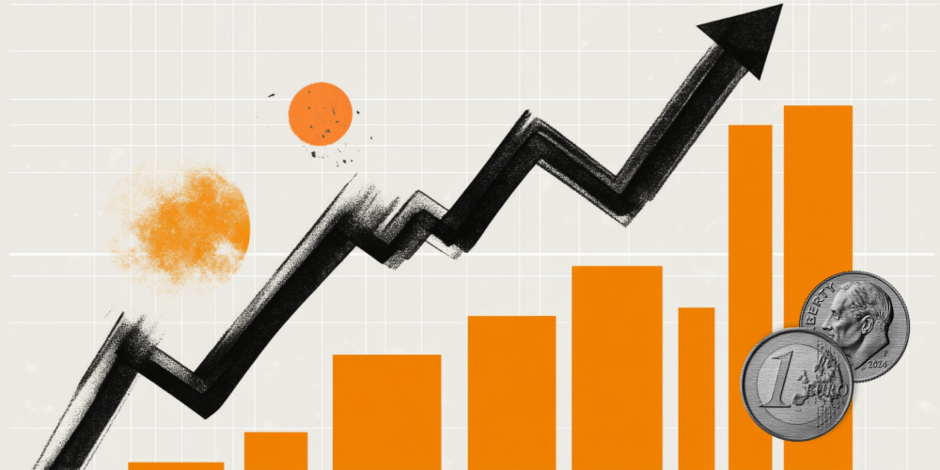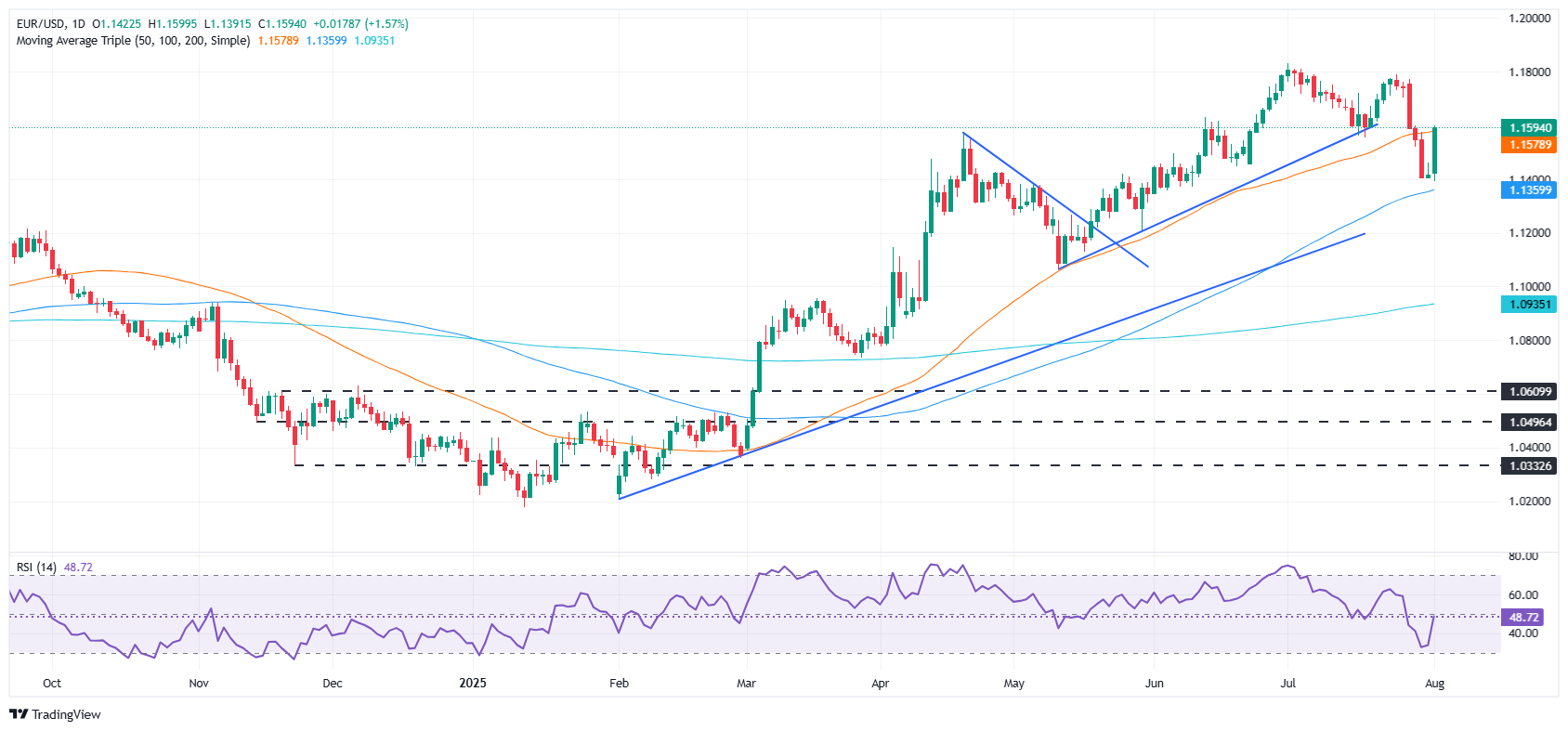Created
: 2025.08.02














![]() 2025.08.02 06:00
2025.08.02 06:00
The EUR/USD surges more than 1% on Friday as the Greenback gets battered on a worse-than-expected jobs report in the United States (US), which triggered investors' reaction to price in two interest rate cuts by the Federal Reserve (Fed). Data across the pond was shrugged off by traders, which sent the pair from around lows of 1.1391 toward 1.1597.
Wall Street extended its losses amidst fears of an economic slowdown in the US. July Nonfarm Payroll (NFP) figures were expected to be weaker compared to June's, but the downward revisions of the previous two months, alongside last month's print, drove the EUR/USD higher.
Alongside this, the Institute for Supply Management (ISM) revealed that manufacturing activity contracted. Meanwhile, the University of Michigan (UoM) Consumer Sentiment in June deteriorated, ending a bad day of economic reports for the US economy.
Following the NFP, traders immediately rushed to price in interest cuts by the Fed. Before the announcement, investors expected 34 bps of easing. At the time of writing, the CBOT December 2025 fed funds rate contract shows nearly 62 bps of easing towards the year's end.
The odds for a 25 bps rate cut by the Fed at the September meeting are at 76%, according to Prime Market Terminal data.
Across the pond, the European Union's July Harmonized Index of Consumer Prices (HICP) came in unchanged at 2.4% YoY, defying expectations for a slight dip to 2.3%. Core HICP remained steady at 2.0%, slightly above the 1.9% forecast, suggesting that underlying inflationary pressures remain firm.
The formation of a 'morning star' candlestick chart pattern indicates that the EUR/USD might resume its uptrend, but it would face key resistance at 1.1600. The Relative Strength Index (RSI) bounced off nearly oversold territory, closing into its neutral line. That said, a cross above 50 would confirm that buyers are in charge.
If EUR/USD clears the 20-day Simple Moving Average (SMA) at 1.1645, a move to 1.1700 is on the cards. On further strength, the next key resistance will be 1.1800 and the year-to-date (YTD) high at 1.1830.
On the flipside, a drop below the 50-day SMA at 1.1576 clears the way to 1.1550, subsequently followed by the 1.1500 figure. The next area of interest would be August's low of 1.1391.

The Euro is the currency for the 19 European Union countries that belong to the Eurozone. It is the second most heavily traded currency in the world behind the US Dollar. In 2022, it accounted for 31% of all foreign exchange transactions, with an average daily turnover of over $2.2 trillion a day. EUR/USD is the most heavily traded currency pair in the world, accounting for an estimated 30% off all transactions, followed by EUR/JPY (4%), EUR/GBP (3%) and EUR/AUD (2%).
The European Central Bank (ECB) in Frankfurt, Germany, is the reserve bank for the Eurozone. The ECB sets interest rates and manages monetary policy. The ECB's primary mandate is to maintain price stability, which means either controlling inflation or stimulating growth. Its primary tool is the raising or lowering of interest rates. Relatively high interest rates - or the expectation of higher rates - will usually benefit the Euro and vice versa. The ECB Governing Council makes monetary policy decisions at meetings held eight times a year. Decisions are made by heads of the Eurozone national banks and six permanent members, including the President of the ECB, Christine Lagarde.
Eurozone inflation data, measured by the Harmonized Index of Consumer Prices (HICP), is an important econometric for the Euro. If inflation rises more than expected, especially if above the ECB's 2% target, it obliges the ECB to raise interest rates to bring it back under control. Relatively high interest rates compared to its counterparts will usually benefit the Euro, as it makes the region more attractive as a place for global investors to park their money.
Data releases gauge the health of the economy and can impact on the Euro. Indicators such as GDP, Manufacturing and Services PMIs, employment, and consumer sentiment surveys can all influence the direction of the single currency. A strong economy is good for the Euro. Not only does it attract more foreign investment but it may encourage the ECB to put up interest rates, which will directly strengthen the Euro. Otherwise, if economic data is weak, the Euro is likely to fall. Economic data for the four largest economies in the euro area (Germany, France, Italy and Spain) are especially significant, as they account for 75% of the Eurozone's economy.
Another significant data release for the Euro is the Trade Balance. This indicator measures the difference between what a country earns from its exports and what it spends on imports over a given period. If a country produces highly sought after exports then its currency will gain in value purely from the extra demand created from foreign buyers seeking to purchase these goods. Therefore, a positive net Trade Balance strengthens a currency and vice versa for a negative balance.
![]()
Created
: 2025.08.02
![]()
Last updated
: 2025.08.02

FXStreet is a forex information website, delivering market analysis and news articles 24/7.
It features a number of articles contributed by well-known analysts, in addition to the ones by its editorial team.
Founded in 2000 by Francesc Riverola, a Spanish economist, it has grown to become a world-renowned information website.
We hope you find this article useful. Any comments or suggestions will be greatly appreciated.
We are also looking for writers with extensive experience in forex and crypto to join us.
please contact us at [email protected].
Disclaimer:
All information and content provided on this website is provided for informational purposes only and is not intended to solicit any investment. Although all efforts are made in order to ensure that the information is correct, no guarantee is provided for the accuracy of any content on this website. Any decision made shall be the responsibility of the investor and Myforex does not take any responsibility whatsoever regarding the use of any information provided herein.
The content provided on this website belongs to Myforex and, where stated, the relevant licensors. All rights are reserved by Myforex and the relevant licensors, and no content of this website, whether in full or in part, shall be copied or displayed elsewhere without the explicit written permission of the relevant copyright holder. If you wish to use any part of the content provided on this website, please ensure that you contact Myforex.
Myforex uses cookies to improve the convenience and functionality of this website. This website may include cookies not only by us but also by third parties (advertisers, log analysts, etc.) for the purpose of tracking the activities of users. Cookie policy